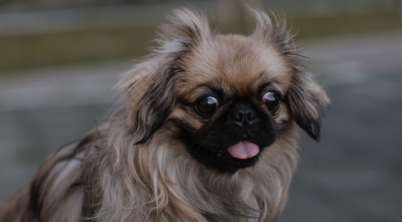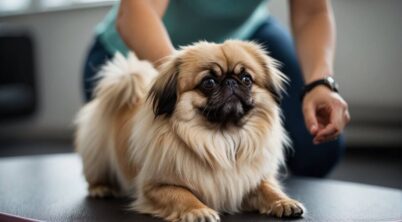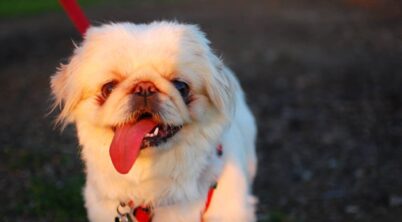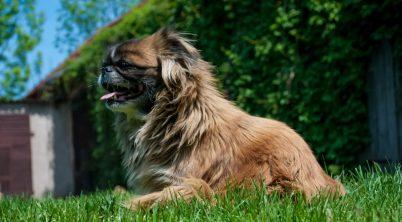The Pekingese breed boasts a noble lineage dating back over two millennia to the imperial courts of ancient China. Valued for their close resemblance to the mythical Chinese guardian lion, the Pekingese became a symbol of nobility and grandeur, enjoying the adoration of Chinese emperors and aristocrats alike. This esteem, coupled with their distinctive look and demeanor, has carved a unique historical niche for the Pekingese, extending far beyond the confines of China’s past.
In a notable historical event connecting the Pekingese to Western history, a dog named Looty found herself at the center of a cultural crossover from East to West. Looty was a female Pekingese taken from the Old Summer Palace near Beijing during the looting by British and French troops in the Second Opium War in 1860. Captain John Hart Dunne acquired the small dog amid the turmoil and subsequently presented her to Queen Victoria as part of the Royal Collection of Dogs. The name Looty, given by Queen Victoria herself, alludes to the dog’s controversial origin.
The arrival of the first Pekingese in England, represented by Looty, marked the beginning of a new chapter for the breed in the Western world. Queen Victoria’s adoption of Looty not only provided the Pekingese with royal patronage but also sparked interest among Britain’s elite. The breed’s quiet but keen demeanor belied its tumultuous history, yet it went on to inspire a newfound fascination among Victorian England’s upper classes, eventually becoming a beloved pet and a symbol of luxury in the West.
Table of Contents
Pekingese Queen Victoria
The Pekingese breed holds a significant place in the history of British royalty due to Queen Victoria’s ownership of a Pekingese dog named Looty. This dog became a notable figure within the Royal Collection of Dogs, her presence embodying both the fascination and intrigue associated with Eastern cultures during the Victorian era.
Origin of Looty:
- Acquisition: Looty was acquired during the looting of the Old Summer Palace near Beijing in October 1860.
- Introduction to England: Presented to Queen Victoria by Captain John Hart Dunne.
- Significance: Possibly the first Pekingese to arrive in England.
Reception at Court:
- Royal Opinion: Despite Looty’s controversial origins, she was accepted into the Royal Collection of Dogs.
- Impact: Looty’s presence initiated a trend among Britain’s upper classes, contributing to the popularity of the Pekingese breed.
Cultural Impact:
- While Looty was integrated into British high society, her appropriation also reflected broader themes of imperialism.
- Her backstory served as a symbol of British imperial exploits of the era.
| Feature | Description |
|---|---|
| Breed | Pekingese |
| Sex | Female |
| Name | Looty |
| Arrival | First Pekingese in England (1860s) |
| Gifted by | Captain John Hart Dunne |
| Symbolism | British imperialism and Eastern intrigue |
Looty’s legacy is not just one of companionship but also an emblem of the historical context of her times, indicative of both cultural exchange and the history of colonialism.
History of the Pekingese Breed
The Pekingese breed boasts a storied history entwined with Chinese royalty and a significant interaction with Western societies during the Opium Wars.
Origins in Ancient China
The Pekingese dog hails from ancient China, believed to have existed for over a millennium. They are closely associated with the city of Beijing, formerly known as Peking, which is home to the Forbidden City. This breed is deeply rooted in Chinese culture and was revered within the court of the Chinese Emperor.
The Pekingese and the Imperial Family
Within the walls of the Imperial Summer Palace and the Forbidden City, the Pekingese served as a cherished companion to the Chinese Imperial Family. During the Qing Dynasty, they were exclusively owned by royalty; it was forbidden for anyone else to keep them. The handling of these esteemed dogs was often entrusted to eunuchs who were responsible for the care and breeding of the Pekingese.
Pekingese Dogs during the Opium Wars
It was during the Opium Wars in the mid-19th century that the Pekingese made a dramatic entry into Western awareness. British and French troops invaded the Imperial Summer Palace, and in the process, they discovered and transported several of these dogs to England, presenting one of them to Queen Victoria. This event was pivotal in introducing the breed to Europe and subsequently to broader Western circles.
Looty and the Second Opium War
The tale of Looty intertwines the history of the Pekingese breed with a pivotal moment in Sino-British relations during the Second Opium War.
Looty’s Place in History
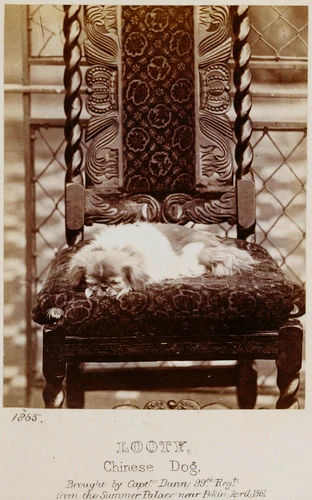
In the annals of Sino-British relations, the capture of a small dog named Looty marks a curious footnote. Looty was one of the first Pekingese dogs to reside in England, symbolizing a trend of fascination with Chinese commodities that was influenced by British Imperialism.
The Capture from the Summer Palace
In October 1860, during the height of the Second Opium War, British and French troops carried out the looting and destruction of the Old Summer Palace, Yuanmingyuan. Among the spoils was Looty, taken from the imperial grounds—a palace renowned for its vast collection of Chinese art and architecture.
Aftermath and Effects on Sino-British Relations
Following Looty’s acquisition, the dog was presented to Queen Victoria as a trophy of war, a living symbol of British triumph. This act of looting and subsequent gifting was reflective of the larger dynamics of power and cultural imperialism at play during and after the Opium Wars. The inclusion of Looty in Queen Victoria’s court hinted at both a curiosity for and a diminution of Chinese heritage, which had complex effects on the Sino-British relationship of the time, signaling a deepening cultural chasm alongside the political strife.
Queen Victoria’s Pekingese
Queen Victoria’s introduction of the Pekingese dog to the British royal household marked a significant moment in European dog breeding, with the little dog becoming a cherished part of the Royal Collection of Dogs at Windsor Castle.
Acquisition and Impact on European Dog Breeding
In 1860, during the looting of the Old Summer Palace in Beijing, Captain John Hart Dunne acquired a female Pekingese dog. This dog was subsequently presented to Queen Victoria, who named her “Looty.” She holds the distinction of possibly being the first Pekingese dog in England. Looty’s presence in the queen’s royal menagerie sparked an interest in the breed among British nobility, contributing to the Pekingese’s status as a desirable breed.
The Kennel Club, established in 1873, would later recognize the Pekingese as a breed, setting standards that guided its breeding in Europe. The introduction of Pekingese into the Royal Collection of Dogs influenced dog breeding circles and helped to establish Windsor as a pivotal location for canine pedigree development.
The Royal Collection of Dogs at Windsor Castle
Windsor Castle became known for housing Queen Victoria’s extensive collection of dogs, which was both a personal interest and an embodiment of royal status and affection for animals. It was typical for portraits and photographs of the royal dogs to be commissioned. Looty was no exception, as her image is part of the historical records, reflecting her prestigious position within the royal household.
Within the Royal Collection of Dogs, the Pekingese Looty was celebrated and likely lived among lavish surroundings, receiving the utmost care which would have been customary for any pet owned by Queen Victoria. This care extended to ensuring the dogs were well-groomed and bred suitably, likely contributing to Looty’s historical significance as a progenitor of the breed in Western Europe.
Cultural Significance and Symbolism
The Pekingese breed carries a deep cultural significance, particularly in relation to its Chinese origins and its representation in various art forms.
Pekingese in Art and Literature
In the realm of art and literature, the Pekingese dog has been a subject of fascination. These animals, often referred to as “Lion Dogs”, have been depicted in various historical artifacts that show their prestigious status amidst the Chinese Royals. The Pekingese’s appearance in art stretches from ancient scrolls to modern paintings, where they are often portrayed with a lion-like mane—an allusion to their nickname and their believed sacred connection to the lion, an animal symbolic to Buddhism and Chinese culture.
The Breed as a Symbol of Chinese Culture
The Pekingese’s significance goes beyond its artistic representations, as it also stands as a potent symbol in Chinese culture. Historically, Pekingese dogs lived with Chinese royals and were regarded as semi-divine creatures. They were closely linked to the lion, which was believed to be a Buddhist symbol of spiritual awakening and protection. Hence, the moniker Pekingese Lion Dog conveys not just the breed’s physical characteristics but also its spiritual metaphor in Buddhist traditions. Their presence among the elites was so revered that commoners had to bow to them, and their treatment was a far cry from any form of torture; they lived lives of luxury and were safeguarded by the highest echelons of society, reflecting the complex interplay between cultures, religion, and the animal’s esteemed stature.
Pekingese in Modern Society
The Pekingese is a toy breed that has managed to maintain its unique status within modern society, fulfilling roles from a cherished pet to a show dog conforming to standards set by kennel clubs.
Current Breed Popularity and Standards
Popularity: The Pekingese dog maintains a steady popularity due to its distinctive appearance and royal heritage. It ranks as a well-loved toy dog, enjoyed for its companionship across various households. However, it’s not among the top breeds when compared to others within the toy group, yet it retains a dedicated following.
Breed Standards: Kennel clubs across the world recognize the Pekingese as a toy breed and have set standards that dictate its appearance and temperament. The American Kennel Club (AKC), for example, describes the breed as “confident,” “dignified,” and “good-natured,” alongside specific physical standards. These include:
- Overall Appearance: Compact, heavier in front than back, with a distinct “rolling” gait.
- Head: Large, broad with a wide skull, flat between the ears; eyes are large, dark, and round.
- Coat: Long, with a thick undercoat and straight outer coat, forming a mane around the shoulders.
- Size: Small but sturdy, typically weighing up to 14 pounds.
While standards may vary slightly from one kennel club to another, the essence of the breed’s description remains focused on preserving the Pekingese’s historical and aesthetic qualities. Breeders, owners, and dog shows play key roles in maintaining these standards, ensuring that Pekingese dogs continue to embody their traditional characteristics.

